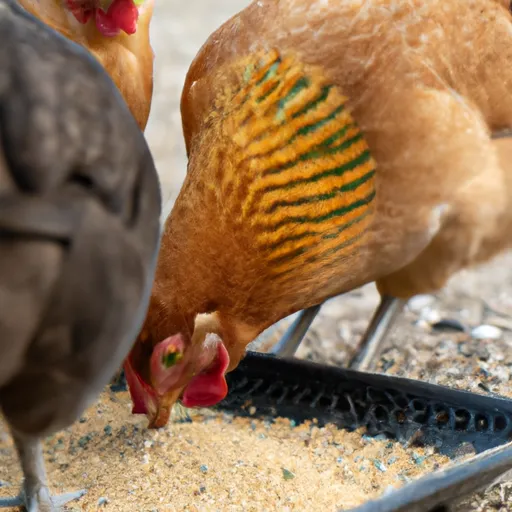Organic Chicken Feed: Why It’s the Best Choice for Your Flock
Have you ever wondered what goes into your chickens’ food?
If you’re like most poultry owners, you probably haven’t given it much thought. But did you know that not all chicken feed is created equal?
In fact, there are significant differences between organic and non-organic feeds that can have a big impact on both your birds’ health and the quality of their eggs or meat.
In this article, we’ll explore why choosing an organic chicken feed is the best choice for your flock.
We’ll cover everything from understanding the different types of chicken feed to how often and how much to feed your birds.
By the end of this post, you’ll be equipped with the knowledge you need to make informed decisions about your poultry’s nutrition.
Introduction to Organic Chicken Feed
Let’s start by defining what “organic” means when it comes to chicken feed.
According to the USDA, organic chicken feed must meet certain requirements in order to earn the organic label.
These include:
- No synthetic pesticides, fertilizers, or other chemicals may be used in the production of the feed.
- The feed must contain at least 95% organically produced ingredients (excluding water).
- Antibiotics and hormones cannot be added to the feed.
- The feed must come from animals raised under humane conditions.
As you can see, these standards ensure that the feed is free from harmful chemicals and additives that could negatively affect your birds’ health.
Additionally, because organic farming practices prioritize sustainability and environmental responsibility, choosing organic chicken feed helps support more responsible agriculture practices overall.
The Benefits of Choosing Organic Chicken Feed
Now that we understand what makes organic chicken feed unique, let’s talk about some of its benefits.
See also Nutrena vs Purina vs Organic: Which Chicken Feed is Right For You
Here are just a few reasons why choosing organic is the best choice for your flock:
1. Better Nutrition – Organic chicken feed contains higher levels of vitamins, minerals, and amino acids than conventional feeds. This translates to stronger, healthier birds that produce better eggs and meat.
2. Improved Digestion – Because organic chicken feed doesn’t contain GMOs or artificial preservatives, it’s easier for your birds to digest. This means less waste and cleaner coops!
3. Reduced Risk of Disease – Non-organic chicken feed can contain antibiotic residues and other contaminants that increase the risk of disease. With organic feed, however, you can rest easy knowing that your birds aren’t being exposed to dangerous chemicals.
4. Supporting Sustainable Agriculture – As mentioned earlier, organic farming practices prioritize sustainability and environmental responsibility. By choosing organic chicken feed, you’re supporting these values and helping to create a better future for our planet.
Understanding the Different Types of Chicken Feed
There are several different types of chicken feed available, each designed to meet specific needs.
Let’s take a look at some of the most common options:
1. Layer Pellets – Designed specifically for laying hens, layer pellets provide balanced nutrition to help promote strong egg production. They typically contain high levels of calcium and protein to support shell formation and tissue growth.
2. Starter/Grower Crumbles – For young chicks, starter/grower crumbles offer the right balance of protein, fat, and energy to encourage rapid growth and development.

3. Scratch Grain – While not technically a type of feed, scratch grain provides a fun treat for your birds while also promoting natural pecking behavior. It can also help improve digestion and reduce boredom.
See also Getting More from Your Pullets: The Importance of Proper Nutrition for Optimal Egg Size
4. Meat Bird Mash – Designed for broilers and other meat breeds, meat bird mash offers high levels of protein and calories to promote fast weight gain and optimal carcass size.
How Much and When to Feed Your Flock: A Consumption Chart
One of the biggest challenges facing poultry owners is figuring out exactly how much and when to feed their birds.
To simplify things, here’s a general guideline based on average consumption rates:
Chicks up to six weeks old should receive unlimited access to starter/grower crumbles. After six weeks, switch them to layer pellets.Adult layers – will consume approximately 1/4 cup of layer pellets per day, although individual needs may vary depending on activity level and climate.
Broilers – and other meat breeds require significantly more feed than layers due to their faster growth rate.
On average, they’ll eat around 2 pounds of meat bird mash per week during the first month of life, tapering off as they approach slaughter weight.
Remember to always keep fresh water available alongside any feed you provide.
Why Organic Chicken Feed is the Best Choice for Your Flock
Choosing organic chicken feed isn’t just good for your birds; it’s good for the environment too.
By providing your flock with clean, responsibly sourced nutrition, you’re taking steps toward creating a more sustainable and responsible agricultural system. So don’t settle for second-rate feeds – have a look at organic instead!
